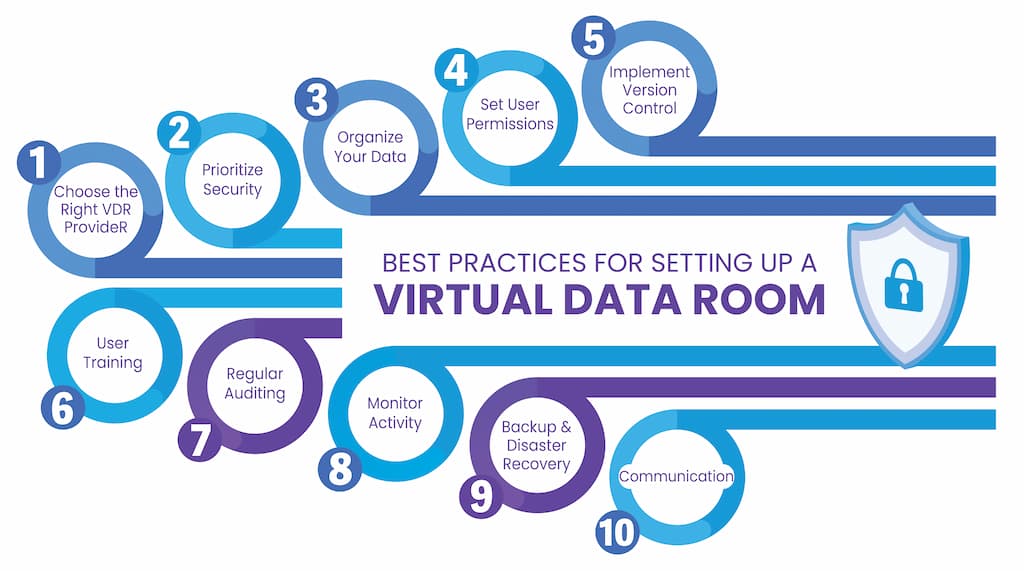In today’s digital age, the management and secure sharing of sensitive information are critical aspects of business operations. Whether it’s a merger and acquisition deal, fundraising, due diligence, or any other type of business transaction, utilizing a virtual data room (VDR) has become a standard practice.
A virtual data room is a secure online repository where organizations can store and share confidential documents with authorized parties. To ensure the utmost security, efficiency, and professionalism, following best practices when setting up a virtual data room is paramount.

1. Choose the Right VDR Provider
Selecting the right VDR provider is the foundation of a successful virtual data room setup. Look for a provider that offers robust security features, a user-friendly interface, customizable permissions, and excellent customer support. Read reviews, talk to colleagues, compare features, and consider the provider’s experience and reputation in your industry before making a decision. For a comparison of popular VDR providers, click here.
2. Prioritize Security
Security is non-negotiable when it comes to virtual data rooms. Your VDR should utilize advanced encryption protocols to protect data during transmission and while at rest. AES-256 (Advanced Encryption Standard) is a widely used symmetric encryption algorithm renowned for its robust security and versatility. Employing a 256-bit key length, it ensures a high level of protection against brute-force attacks, making it a favored choice for safeguarding sensitive data. AES-256 operates on fixed-size blocks of data, transforming plaintext into ciphertext through a series of intricate substitution, permutation, and mixing operations. Its widespread adoption in various domains, including data protection, secure communications, and financial transactions, attests to its reliability and effectiveness in maintaining confidentiality and integrity.
In addition to utilizing advanced encryption protocols, two-factor authentication should be implemented for user logins, and the provider should adhere to industry standards and compliance regulations, such as GDPR or HIPAA, depending on your business needs. Some advanced security features might also include:
- Remote Shredding
- Granular Access Controls
- Secure Printing
- Dynamic Watermarking
- Expiration Date and Time
- Disable Print, Save, Copy/Paste, and Screenshots
3. Organize Your Data
Efficient data organization is key to a smooth VDR experience. Before uploading any documents to your VDR, take the time to plan a well-thought-out folder structure. Consider the specific needs of your project or business and how users will interact with the documents. Start with high-level categories that align with the purpose of the VDR, and then break them down into subfolders as needed. A clear folder structure improves navigation and prevents confusion. Some VDR platforms provide a Due Diligence Checklist which automatically populates your data room with folders and categories relevant to your industry.
4. Set User Permissions
Controlling access to documents is essential during due diligence and other sensitive business processes. Assign different permission levels to users based on their roles and responsibilities. Some users might need view-only access, while others might require the ability to download, upload, or edit documents. Regularly review and update permissions as roles change.
Organizations engaged in due diligence can significantly enhance their security posture and mitigate the risks associated with unauthorized access and data breaches by implementing the concept of Least Privilege Access. Least privilege access is a security concept that restricts user permissions to only those necessary to perform their job functions. It revolves around the idea of providing users with the minimum levels of access rights required to complete their tasks successfully. Instead of granting broad and unrestricted access, least privilege access ensures that users are confined to accessing only the specific resources, systems, and information they need to perform their roles effectively.
5. Implement Version Control
Version control ensures that everyone is working with the most up-to-date documents. When a document is updated, the previous version should be archived, and the new version should be clearly labeled. This prevents confusion and reduces the risk of outdated or incorrect information being used.
6. User Training
Provide thorough training to all users who will be using the virtual data room. This includes internal team members as well as external parties. Familiarize them with the platform’s features, navigation, and security measures. Well-trained users are less likely to make mistakes that could compromise data security.
7. Regular Auditing
Conduct regular audits of your VDR to ensure that it’s being used properly and that data is being accessed by authorized individuals only. Regular checks can help identify and address any potential security vulnerabilities or breaches. Consider a VDR platform that offers IP Address Tracking. IP Address Tracking lets the VDR administrator track the IP addresses of their users, with built-in geolocation and organization lookup, so they can see where their users are logged in from as they access the VDR’s data.
8. Monitor Activity
Most VDR providers offer activity tracking features. Monitoring user activity can help admins track who has accessed which documents, when, and for how long. This audit trail can be invaluable for compliance, accountability, deal intelligence, and resolving any disputes that may arise.
9. Backup and Disaster Recovery
Ensure that your VDR provider has a robust backup and disaster recovery plan in place. Data loss can occur due to various reasons, and having a reliable backup strategy can prevent critical information from being irretrievably lost. Look for a VDR provider that offers multiple levels of redundancy across geographically diverse data centers.
10. Communication
Lastly, clear communication with all involved parties is essential. Inform users of the purpose and rules of the VDR, how to access it, and how to reach out for support if needed. Also, establish a point of contact for any technical issues or questions. Look for a VDR platform that offers world-class 24/7 support.
In conclusion, setting up a virtual data room is a strategic move that requires careful planning and execution. By selecting a reputable provider, prioritizing security, organizing data efficiently, setting appropriate user permissions, and adhering to best practices, you can ensure that your virtual data room serves its purpose effectively—facilitating secure and streamlined information sharing for your critical business transactions.
ShareVault has been providing organizations of all types and sizes with secure document sharing solutions for over 15 years.







